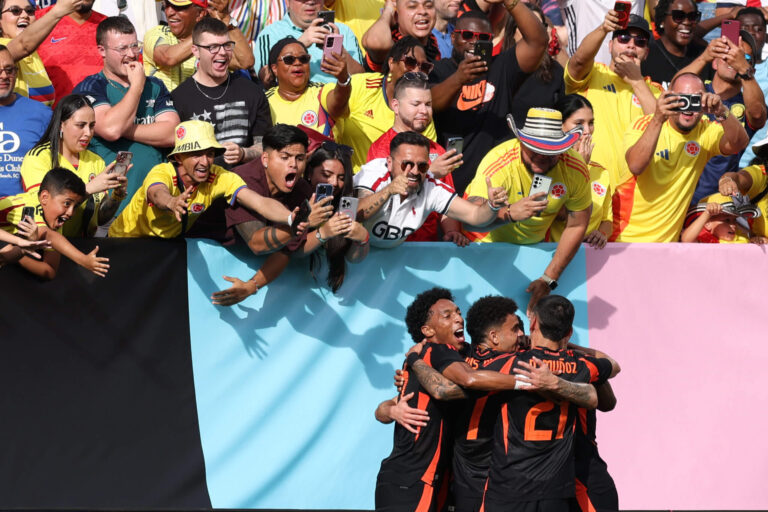Commanders Field, home of the NFL’s Washington Commanders, had plenty of space for pregame tailgate parties and the parking lots surrounding the facility were packed with revelers. The smell of grilled meat wafted through the air on Saturday afternoon as fans soaked up the summer sunshine and prepared to watch the USMNT host Colombia in a Copa America warm-up match.
On the surface, the match against Colombia was a home game for the United States and a tune-up for the upcoming Copa America, which the U.S. will host. But the sights and sounds in the parking lot told a different story.
There was no sea of red, white and blue. There was a sea of yellow and red. The music wasn’t classic rock, but the thumping beats of cumbia, a traditional Colombian music. There was a distinctly Latin American feel to the scene outside, and later inside, the stadium, not far from the U.S. Capitol.

Colombia fans make their presence known (Roberto Schmidt/AFP via Getty Images)
The Washington, D.C., area has a sizable Colombian-American population, but New York City and the surrounding New Jersey area have the largest concentration of Colombians in the U.S., and many fans drove up I-95 to cheer on Los Cafeteros, including several from Colombia, like Hilario Lopez, 67, of Cartagena.
“We’re going to follow them,” Lopez said. “We’re going to follow them wherever they go.”
A few minutes later, Lopez and those around him celebrated when Colombia took an early first-half lead, and soon after, a sizable portion of the crowd began chanting, “USA, Colombia is your daddy” after Rafael Santos Borre’s bicycle kick put Colombia two up.
“America, Colombia is your father. “
The USMNT fans nearby looked out of place among the crowd of 55,494 and were as skeptical as ever. These kinds of “hometown” fans are nothing new to them. The United States is large and diverse, and nearly every opponent the USMNT faces, especially those from Latin America, has a significant immigrant population somewhere in the country.
For many years, the U.S. Soccer Association has hosted its matches against these opponents, particularly Mexico, in cities with large immigrant populations from those countries.
There are exceptions, especially in meaningful competitions, but they still happen.

Colombia fans had plenty to cheer about (Roberto Schmidt/AFP via Getty Images)
In 2021, in the inaugural CONCACAF Nations League, the U.S. beat Mexico in the final in Denver before a predominantly Mexican crowd, with U.S. winger Christian Pulisic silencing the crowd with a goal celebration that immortalized the moment. Just last year, the U.S. beat El Tri again in front of a similarly biased crowd in Arlington, Texas, where the Copa America kicks off in a few weeks.
“I think it’s great. It’s a celebration,” USMNT coach Gregg Berhalter said after the match. “Our job is to engage the fans, make it a fun show and really compete. We know in games like this, the crowd leans towards the other team and we expect the same thing on Wednesday against Brazil in Orlando.”
Saturday’s game against Colombia was one of two warm-up matches the U.S. had planned for the Copa America, one of the world’s oldest international soccer tournaments. The tournament has never been played outside of South America, except for the 2016 Copa America Centenario, which was played in the U.S. The U.S. will face Bolivia, Panama and Uruguay in the group stage, and can expect stronger support in Arlington; Atlanta, Georgia; and Kansas City, Missouri, where those games will be played.
But as they move forward, every aspect of their path becomes more difficult, including the atmosphere.

Richard Rios celebrates after scoring Colombia’s third goal (Roberto Schmidt/AFP via Getty Images)
The quarterfinal opponent, likely Colombia or Brazil, would be a matchup with a team that has widespread support in the U.S. and would draw a significant number of general public fans. Financial benefits aside, that’s why the tournament is being held in the U.S. in the first place: Nearly every team in the tournament has some level of support in the U.S. It would create a better atmosphere and, more importantly, better ticket sales.
The average attendance at the 2016 Copa America was more than 46,000. The year before in Chile, average attendance at matches was 25,000.
On Saturday, Pulisic was much more brief in his assessment of the atmosphere and the lack of U.S. support than Berhalter.
“I think it’s pretty standard,” Pulisic told reporters.
Although the U.S. struggled in the second half against Colombia, losing 5-1, most fans went home in joy, chanting “America, Colombia, your daddy” as the team’s two-year unbeaten streak extended to 22 games.

Going deeper
BRIEFING: USMNT 1, Colombia 5 – Berhalter calls loss ‘wake-up call’
(Top photo: John Doughton/Getty Images for USSF)

